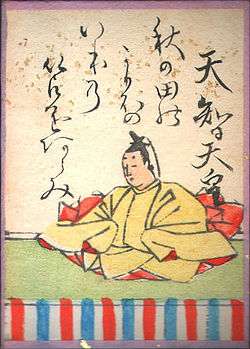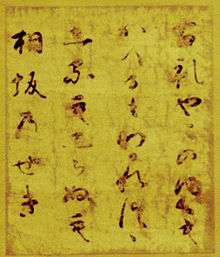Ogura Hyakunin Isshu


Ogura Hyakunin Isshu (小倉百人一首) is a classical Japanese anthology of one hundred Japanese waka by one hundred poets. Hyakunin isshu can be translated to "one hundred people, one poem [each]"; it can also refer to the card game of uta-garuta, which uses a deck composed of cards based on the Ogura Hyakunin Isshu.
It was compiled by Fujiwara no Teika while he lived in the Ogura district of Kyoto, Japan.[1]
Compilation
One of Teika's diaries, the Meigetsuki, says that his son, Fujiwara no Tame'ie, asked him to arrange one hundred poems for Tame'ie's father-in-law, who was furnishing a residence near Mount Ogura;[2] hence the full name of "Ogura Hyakunin Isshu". In order to decorate screens of the residence, Fujiwara no Teika produced the calligraphy poem sheets.[3]
Hishikawa Moronobu provided woodblock portraits for each of the poets included in the anthology.[4]
In his own lifetime, Teika was better known for other work. For example, in 1200 (Shōji 2), Teika prepared another anthology of one hundred poems for ex-Emperor Go-Toba. This was called the Shōji Hyakushu.[5]
Poets
- Emperor Tenji (天智天皇)
- Empress Jitō (持統天皇)
- Kakinomoto no Hitomaro (柿本人麻呂)
- Yamabe no Akahito (山部赤人)
- Sarumaru no Taifu (猿丸大夫)
- Ōtomo no Yakamochi (中納言家持)
- Abe no Nakamaro (阿倍仲麻呂)
- Kisen Hoshi (喜撰法師)
- Ono no Komachi (小野小町)
- Semimaru (蝉丸)
- Ono no Takamura (参議篁)
- Henjo (僧正遍昭)
- Retired Emperor Yōzei (陽成院)
- Minamoto no Tōru (河原左大臣)
- Emperor Kōkō (光孝天皇)
- Ariwara no Yukihira (中納言行平)
- Ariwara no Narihira (在原業平朝臣)
- Fujiwara no Toshiyuki (藤原敏行朝臣)
- Lady Ise (伊勢)
- Prince Motoyoshi (元良親王)
- Sosei (素性法師)
- Fun'ya no Yasuhide (文屋康秀)
- Ōe no Chisato (大江千里)
- Sugawara no Michizane (菅家)
- Fujiwara no Sadakata (三条右大臣)
- Fujiwara no Tadahira (貞信公)
- Fujiwara no Kanesuke (中納言兼輔)
- Minamoto no Muneyuki (源宗于朝臣)
- Ōshikōchi no Mitsune (凡河内躬恒)
- Mibu no Tadamine (壬生忠岑)
- Sakanoue no Korenori (坂上是則)
- Harumichi no Tsuraki (春道列樹)
- Ki no Tomonori (紀友則)
- Fujiwara no Okikaze (藤原興風)
- Ki no Tsurayuki (紀貫之)
- Kiyohara no Fukayabu (清原深養父)
- Fun'ya no Asayasu (文屋朝康)
- Ukon (右近)
- Minamoto no Hitoshi (参議等)
- Taira no Kanemori (平兼盛)
- Mibu no Tadami (壬生忠見)
- Kiyohara no Motosuke (清原元輔)
- Fujiwara no Atsutada (権中納言敦忠)
- Fujiwara no Asatada (中納言朝忠)
- Fujiwara no Koretada (謙徳公)
- Sone no Yoshitada (曽禰好忠)
- Egyō (恵慶法師)
- Minamoto no Shigeyuki (源重之)
- Ōnakatomi no Yoshinobu (大中臣能宣朝臣)
- Fujiwara no Yoshitaka (藤原義孝)
- Fujiwara no Sanekata (藤原実方朝臣)
- Fujiwara no Michinobu (藤原道信朝臣)
- Michitsuna no Haha (右大将道綱母)
- Takashina no Takako (儀同三司母), also known as Takashina no Kishi or Kō no Naishi
- Fujiwara no Kintō (大納言公任)
- Izumi Shikibu (和泉式部)
- Murasaki Shikibu (紫式部)
- Daini no Sanmi (大弐三位)
- Akazome Emon (赤染衛門)
- Koshikibu no Naishi (小式部内侍)
- Ise no Taifu (伊勢大輔)
- Sei Shonagon (清少納言)
- Fujiwara no Michimasa (左京大夫道雅)
- Fujiwara no Sadayori (権中納言定頼)
- Sagami (相模)
- Gyōson (大僧正行尊)
- Suō no Naishi (周防内侍)
- Retired Emperor Sanjō (三条院)
- Nōin Hōshi (能因法師)
- Ryōzen (良暹法師)
- Minamoto no Tsunenobu (大納言経信)
- Yūshi Naishinō-ke no Kii (祐子内親王家紀伊)
- Ōe no Masafusa (権中納言匡房)
- Minamoto no Toshiyori (源俊頼朝臣)
- Fujiwara no Mototoshi (藤原基俊)
- Fujiwara no Tadamichi (法性寺入道前関白太政大臣)
- Retired Emperor Sutoku (崇徳院)
- Minamoto no Kanemasa (源兼昌)
- Fujiwara no Akisuke (左京大夫顕輔)
- Taiken Mon In no Horikawa (待賢門院堀河)
- Tokudaiji no Sadekata (後徳大寺左大臣)
- Dōin (道因法師)
- Fujiwara no Shunzei (皇太后宮大夫俊成)
- Fujiwara no Kiyosuke (藤原清輔朝臣)
- Shun'e (俊恵法師)
- Saigyō (西行法師)
- Jakuren (寂蓮法師)
- Kōkamonin no Bettō (皇嘉門院別当)
- Princess Shikishi (式子内親王)
- Inpumonin no Taifu (殷富門院大輔)
- Kujō Yoshitsune (後京極摂政前太政大臣)
- Nijōin no Sanuki (二条院讃岐)
- Minamoto no Sanetomo (鎌倉右大臣)
- Asukai Masatsune (参議雅経)
- Jien (前大僧正慈円)
- Saionji Kintsune (入道前太政大臣)
- Fujiwara no Teika (権中納言定家)
- Fujiwara no Ietaka (従二位家隆)
- Retired Emperor Go-toba (後鳥羽院)
- Retired Emperor Juntoku (順徳院)
Poems
Poem number 2[6]
One of the poems attributed to Empress Jitō was selected by Fujiwara no Teika. The text is visually descriptive. From the Shinkokinshū, but the original poem was from the Man'yōshū.
|
Translation
|
Hyakunin Isshu, from the Shinkokinshū
|
Original poem from the Man'yōshū
|
Poem number 26[7]
A quite different poem is attributed to Sadaijin Fujiwara no Tadahira in the context of a very specific incident. After abdicating, former Emperor Uda visited Mount Ogura in Yamashiro province. He was so greatly impressed by the beauty of autumn colours of the maples that he ordered Fujiwara no Tadahira to encourage Uda's son and heir, Emperor Daigo, to visit the same area. Prince Tenshin or Prince Teishin (貞信公 Teishin Kō) was Tadahira's posthumous name, and this is the name commonly associated with a poem which observes that "[t]he maples of Mount Ogura, If they could understand, Would keep their brilliant leaves, until [t]he Ruler of this land Pass with his Royal band."[8] The accompanying 18th century illustration shows a person of consequence riding an ox in a procession with attendants on foot. The group is passing through an area of maples.[9] Fujiwara no Teika chose this poem from the Shūi Wakashū for the Hyakunin Isshu.
|
|
'*'By modern Romanization, "Miyuki matanamu"; pronounced matanan by use of historical kana orthography.
Ogura Hyakunin Isshu, Arashiyama
In November 2003, the Kyoto Chamber of Commerce and Industry founded the Ogura Hyakunin Isshu Cultural Foundation to promote this work of literature and poetic appreciation.[10]
In January 2006, The Ogura Hyakunin Isshu Hall of Fame Shigure-den was completed in Arashiyama.[10] This museum introduces visitors to Hyakunin Isshu using the latest digital technology.[11]
During the following years, 100 monuments inscribed with the 100 poems from the Ogura Hyakunin Isshu are planned for installation in the nearby vicinity.[10]
English translations
The Ogura Hyakunin Isshu has been translated into many languages and into English many times, beginning with Yone Noguchi's Hyaku Nin Isshu in English in 1907.[12] Other translations include William N. Porter, A Hundred Verses from Old Japan (1909); Clay MacCauley, Hyakunin-isshu (Single Songs of a Hundred Poets) (1917); Tom Galt, The Little Treasury of One Hundred People, One Poem Each (1982); Joshua S. Mostow, Pictures of the Heart: The Hyakunin Isshu in Word and Image (1996); Peter McMillan, One Hundred Poets, One Poem Each (2008); and Emiko Miyashita and Michael Dylan Welch, 100 Poets: Passions of the Imperial Court (2008).
Other Hyakunin Isshu anthologies
Many other anthologies compiled along the same criteria—one hundred poems by one hundred poets—include the words hyakunin isshu, notably the World War II-era Aikoku Hyakunin Isshu (愛国百人一首), or One Hundred Patriotic Poems by One Hundred Poets. Also important is Kyōka Hyakunin Isshu (狂歌百人一首), a series of parodies of the original Ogura collection.
Card game
Teika's anthology is the basis for the card game of karuta, which has been popular since the Edo period.[13]
Many forms of playing game with Hyakunin Isshu exist in Japan, such as Uta-garuta. Competitive karuta (Kyogi Karuta) is also played.
Notes
- ↑ Mostow, Joshua. (1996). Pictures of the Heart: The Hyakunin Isshu in Word and Image, p.25.
- ↑ Ogurayama: Latitude: 34° 53' 60 N, Longitude: 135° 46' 60 E; Kyoto Prefecture web site: northwest of Arashiyama Park.
- ↑ Mostow, p.94.
- ↑ Hishikawa, Moronobu; Fujiwara, Sadaie (1680). "100 Poems by 100 Poets". World Digital Library (in Japanese). Retrieved 7 June 2013.
- ↑ Brower, Robert H. "Fujiwara Teika's Hundred-Poem Sequence of the 'Shoji Era'." Monumenta Nipponica. Vol. 31, No. 3 (Autumn, 1976), pp. 223-249.
- 1 2 3 University of Virginia, Hyakunin Isshu on-line
- ↑ Fujiwara no Sadaiie, Clay MacCauley. (1917). Ogura Hyakunin Isshu from Hyakunin-Isshu. Yokohama: Kelly and Walsh, Ltd.
- ↑ Fujiwara no Tadahira. "Prince Teishin" (貞信公 Teishin Kō), A Hundred Verses from Old Japan, Being a Translation of the Hyakunin Isshu, p. 26.
- ↑ Fujiwara no Tadahira, p. 25.
- 1 2 3 Kyoto Chamber of Commerce and Industry: Ogura Hyakunin Isshu, Arashiyama
- ↑ Kyoto City Tourism and Culture Information Site: Shigure-den
- ↑ Yone Noguchi, Hyaku Nin Isshu in English, Waseda Bungaku (1907)
- ↑ Honan, William H. "Why Millions in Japan Read All About Poetry," New York Times. March 6, 2000.
See also
- Nisonin, Kyoto
References
- Fujiwara no Sadaie, Thomas Galt. (1982). The Little Treasury of One Hundred People, One Poem Each. Princeton: Princeton University Press. ISBN 978-0-691-06514-4
- Fujiwara no Sadaie, Yoritsuna Utsunomiya, William Ninnis Porter. (1979) A Hundred Verses from Old Japan, Being a Translation of the Hyaku-nin-isshiu: Being a Translation of the Hyaku-nin-isshiu. Tokyo: Tuttle Publishing. ISBN 978-4-8053-0853-0
- Mostow, Joshua S., ed. (1996). Pictures of the Heart: The Hyakunin Isshu in Word and Image. Honolulu: University of Hawaii Press. ISBN 978-0-8248-1705-3; OCLC 645187818
Further reading
- One Hundred Poets, One Poem Each: A Translation of the Ogura Hyakunin Isshu, Peter McMillan, foreword by Donald Keene. New York: Columbia University Press, 2008. ISBN 978-0-231-14398-1
- 100 Poets: Passions of the Imperial Court, Emiko Miyashita and Michael Dylan Welch, translators. Tokyo: PIE Books, 2008. ISBN 978-4-89444-757-8 This book is also available as an iPad/iPhone application.
External links
| Wikimedia Commons has media related to Hyakunin Isshu. |
| Wikisource has original text related to this article: |
- Ogura Hyakunin Isshu - 100 Poems by 100 Poets at University of Virginia Library Japanese Text Initiative
| ||||||||||||||||||
|